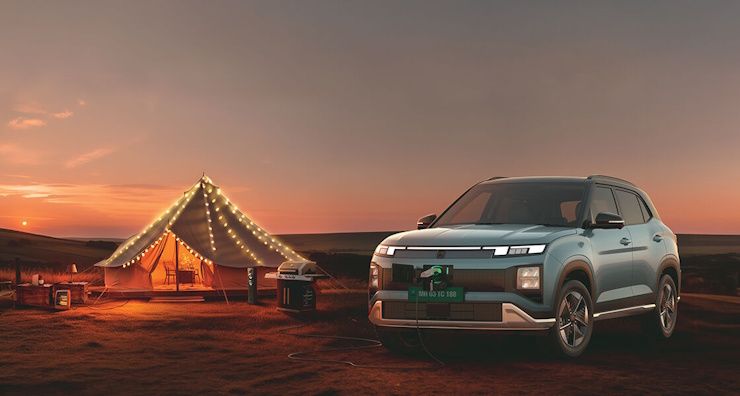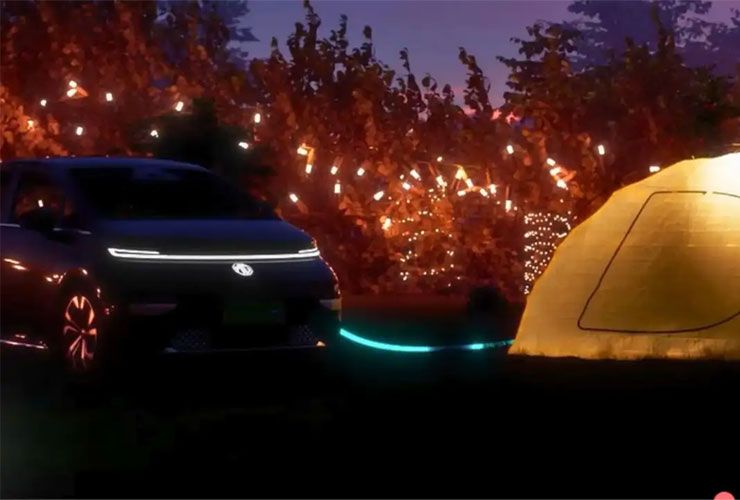Unexpected Benefit: Tata Curvv.EV With V2L Powers Water Pump! (Video)


Vehicle-to-Load (V2L) charging can be very useful in real life. It can have varied use cases. This feature, however, continues to be less explored. The Tata Nexon EV was one of the first electric vehicles to feature V2L. The Curvv.EV that came later also had this feature on offer. A recent video shared online shows a Curvv.EV powering a 1hp water pump, on a farm in India. This electric SUV coupe can thus be the farmer's best friend!
As the video opens, we see a Cruvv.EV parked on a darm. It has the V2L adapter plugged into its charging port. An electric pump set is connected to it, and is turned on. It is seen pumping water from under the ground into a small reservoir. It is essentially a pit which has a plastic sheet spread on it, so that the water stays within.
The person filming walks towards the EV, and says that the V2L is turned on, and the vehicle's 'AC' is working when V2L is in action. This may not be true. He may have heard the vehicle's battery cooling system working and might have thought it to be the AC's sound. Electric vehicles use their battery cooling systems to maintain optimum temperature while V2L or V2V is being used.
Electrical energy and heat are interlinked. The flow of electrical energy (both during charging and discharging) results in heat being produced. Thus, the cooling systems have to be strong on EVs while using V2L and V2V. These often have liquid-to-air or liquid-to-liquid heat exchangers.

Circling back, the internet seems to love the way this Curvv.EV owner chose to flex his vehicle's V2L ability. We have seen most manufacturers resort to scenarios like 'powering camping equipment' to demonstrate V2L.
For instance, MG Motor India chose to conduct the Windsor Pro's first drive event in a scenic, off-beat location. There they used the vehicle's V2L abilities to operate cooking ranges and kettles which made food and hot beverages for the participating journalists. The brand managed to simulate a luxury camping setup with the Windsor Pro. This definitely looks flashy. However, using V2L to operate something like a water pump to collect water on a farm is more realistic and relatable.
The Curvv.EV can be used to power tools (like the pump set in this case) on farms with limited or no access to electricity. It can power loads of up to 3kW. In this case, the water was being drawn for use in construction.

V2L, in simple words, is the technology that lets you use your EV to charge or power electric tools or gadgets. It can be particularly useful in scenarios like power outages, emergencies and more. It can thus reduce reliance on fossil fuel-powered generators and inverters.
EV batteries store power as DC (Direct Current). Appliances, tools and gadgets work on Alternating Current (AC). The battery pack's energy first needs to be converted into AC before it can be used by the connected gadgets (load). Electric vehicles come with an onboard converter ( in other words, an inverter), which does the DC-to-AC conversion.
The energy is first converted into AC and then supplied to the load through the V2L adapter and cable. If you're using the V2L feature of your electric car or SUV, a common recommended practice is to ensure sufficient battery charge before starting V2L operations.

Today, many mass-market electric vehicles that are on sale in India feature V2L charging. Models like the Nexon.EV, Curvv.EV, Punch.EV, Creta Electric, Windsor Pro and the recently-launched Kia Carens Clavis EV come with Vehicle-to-Load (V2L) functionality.